Fluid viscous dampers (FVDs) are used to dissipate energy in a structure caused by seismic and wind events. FVDs can increase structural damping, typically between 15% and 35% in seismic applications, which significantly reduces drifts and stresses in a structure.
Using FVDs allows the structure to remain largely undamaged, improving functional recovery capacity and operability following an earthquake. When used in retrofits, FVDs are used to reduce seismic force and deformation demands below the existing structural capacity, reducing the need for costly widespread system strengthening.
Unlike conventional methods of strengthening buildings by adding more steel, a more efficient solution is to add fluid viscous dampers to the building to absorb the energy of the earthquake. Similar to how shock absorbers work on your car when driving on a bumpy road, dampers can be added to the structure of a building to limit the shock and vibration during an earthquake.
Fluid viscous dampers are velocity dependent and allow the structure to remain elastic as opposed to stiffening the building, which can cause additional problems that can lead to unsafe living conditions.
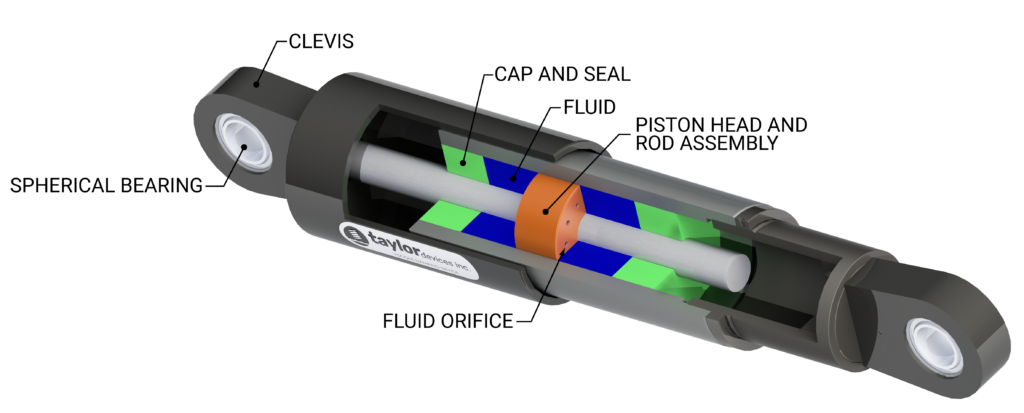

Taylor Dampers can be placed in a variety of different configurations depending on the type of building.
An alternate version of the Chevron, this configuration allows for windows and doors to be unobstructed.
In this configuration, the dampers are placed horizontally, and connected to a frame (chevron) that is intended to be near-rigid with the floor it is connected to. The advantage with this direct damping orientation is that the horizontal flexibility of the structure injects this full movement directly into the horizontal orientation of the damper. However, a small amount of motion can be lost due to the constraints of the attainable stiffness of an economical chevron frame.
A very common method of applying distributed damping to a structure is to connect the dampers to diagonal corners or center of a structural frame or bay. In this orientation, the horizontal movement of the structure allows an angular component of the full deflection to go into the damper. This takes the motion directly to the next floor level through a strong tension/compression member.

Our new Taylor Damped Moment FrameTM (TDMFTM) procedure decouples special steel moment frame design from the damper frame, allowing for easier analytical models, less guess work on damper properties, and smoothing coordination with Taylor Devices.

Fluid viscous dampers can be used in a variety of different applications. Whether it’s stopping vibrations from foot traffic on a bridge, reducing motion at the top of a tall building due to high winds, or protection during a seismic event, fluid viscous dampers provide superior damping to just about any structure. By using viscous damping the structures become velocity sensitive, rather than using hysteric damping which would make them displacement sensitive.

For smaller applications, Taylor Devices also offers a D-Series Damper which can be used for up to 2,000 lbs of output force. This damper is a true linear damping system using a fluidic proportion to velocity input.
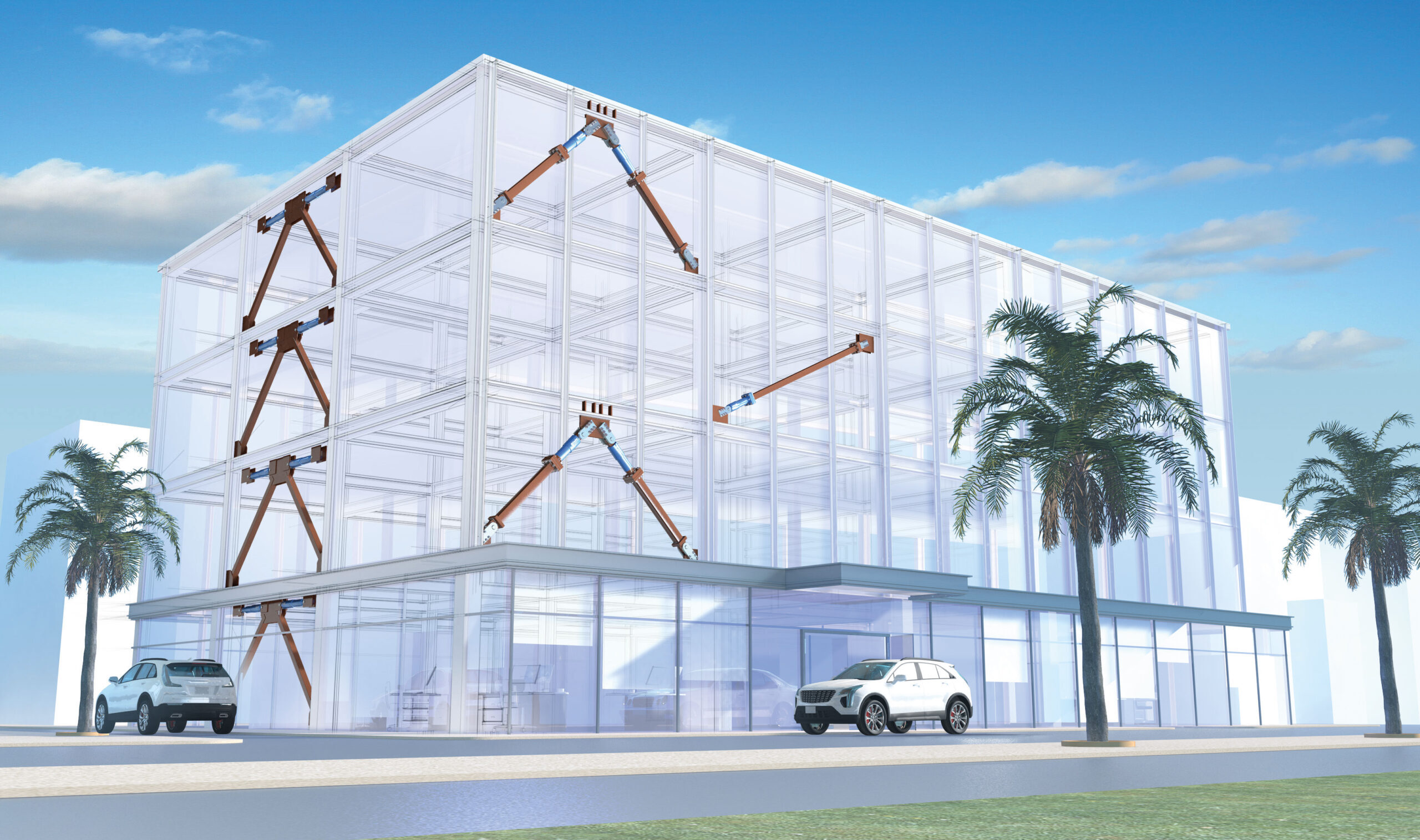
Substantial stress reduction – greatly enhanced damping lowers both stress and deflection throughout a structure. This allows the structure to remain elastic.
Easy to model with existing codes – these dampers are completely viscous in output and will simply and efficiently raise structural damping to 20%-50% of critical, versus 1%-3% for a typical non damping design.
Allows designers to reduce cost of the structure by utilizing smaller structural elements and less complex foundations while improving the dynamic performance of the structure.
The easily installed passive dampers are extremely reliable with no dependence on outside energy sources.
No Maintenance ever required. Taylor Devices exclusive modular design uses a minimum number of moving parts. Patented seal has a history of over 50+ years of successful performance on demanding applications.
Environmentally proven output – stable behavior over a wide temperature range, from -40°F to +160°F. Nonflammable inert fluid and stainless steel piston rods standard on all models.
These dampers are truly viscous, their response is out of phase with structural stresses. Taylor seismic, thermal and wind dampers are available in output force ratings up to 2 million pounds and stroke (amplitude) capacities up to +/-42 inches.
This comprehensive manual is a guide for engineers with various levels of experience to take advantage of this technology to improve the dynamic performance of structures and to help save lives throughout the world.
Adding dampers to new or existing buildings helps to reduce drifts and floor accelerations; dissipates energy through the conversion of motion into heat instead of inelastic behavior in structural elements; improves building resiliency and reduces earthquake-induced damage. Buildings with a supplemental fluid viscous damping system with between 10 to 40 percent of critical damping experience over 50% less displacement than a code prescribed building design; up to a 40% smaller base shear; and over a 50% reduction in floor accelerations. Fluid Viscous Dampers (FVDs) do not change the stiffness of the building, are velocity dependent, have a property variation of less than ±15%, are easy to install, and require no maintenance.
Along with our Taylor Dampers, we also offer a variety of other products and systems that can be used on your project. We analyze your project, and can determine the best solution that will meet your needs. Read more about each of them below.
Similar to a seatbelt in a car, a Lock-Up Device (LUD) allows free movement during slow velocities such as thermal movement and acts as a temporary rigid link during transient events such as earthquakes or train braking on a bridge.
The most common applications are for reducing the size of expansion joints in long span structures or stadiums and to reduce the earthquake load for a fixed pier on a bridge when LUDs are installed on adjacent expansion piers.
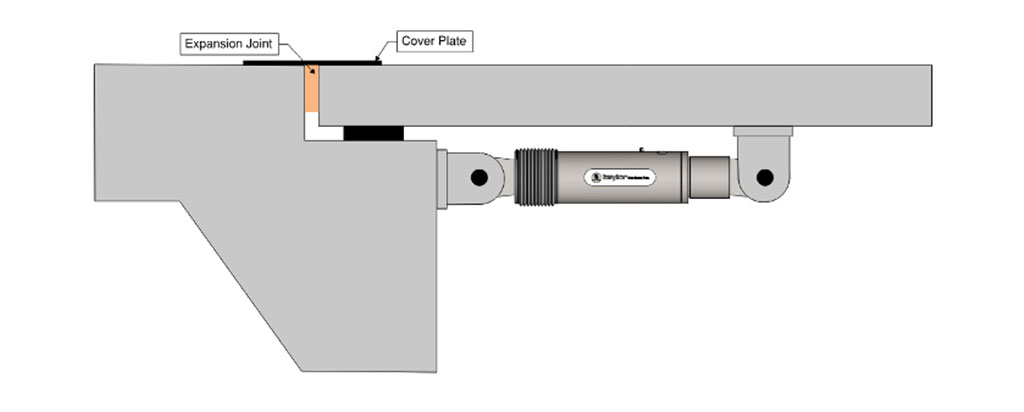
Taylor Dampers halve the building displacements when added to Base Isolation Systems. The reduction in displacement reduces the cost of the isolators, the moats around the building, as well as the services and utilities that are detailed to allow for the building movement. The addition of viscous dampers to the base isolation system increases the amount of energy dissipation during a seismic event improving theperformance of the system.
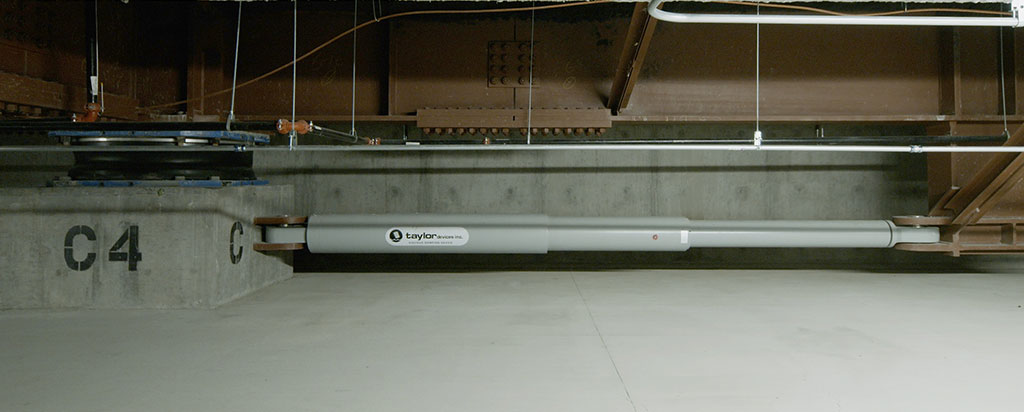
Originally designed for critical military and aerospace applications, these dampers utilize flexible type metal bellows seals rather than conventional sliding type seals. This results in a 100% hermetically sealed design with absolutely zero leakage. They are designed for infinite life by limiting the bellow’s stresses to be less than the material fatigue endurance limits.
The devices provide effective damping at extremely small amplitudes and are ideal for applications such as human-induced vibration for buildings and bridges and for wind vibration when used in damped outriggers and meagabraces on tall buildings

Outrigger systems are commonly used in tall buildings to provide lateral stiffness to the building by connecting the stiff core of the building to the perimeter columns. Traditional outriggers are desirable since they provide the lateral stiffness required to control drift and acceleration caused by wind and seismic events without the need for a large number of concrete shear walls or bracing elements.
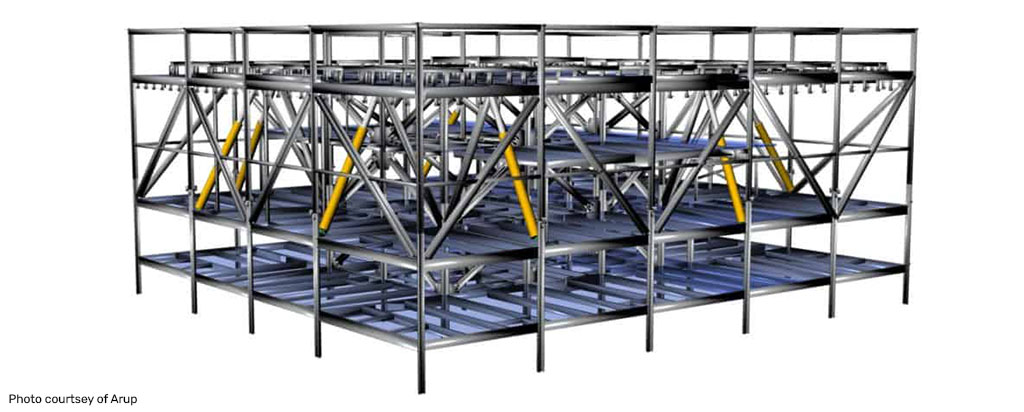
Fluid Visco-Elastic Dampers (FVEDs) combine the technology of Taylor Devices’ traditional fluid viscous damper in series with an internal spring element to provide both damping and stiffness to structures. This targeted approach provides the benefits of FVDs by reducing seismic demands on structures while also allowing designers to provide additional stiffness in desired locations to improve building performance. Doing so makes FVEDs an optimal choice for building with soft stories or torsional irregularities.

When looking for pure damper applications, we offer our D-Series Damper. Available in both single and double acting styles, this damper is a true linear damping system using a fluidic proportion to velocity input. Made of a solid stainless steel piston rod, corrosion protected steel cylinder, this is a modern, monotube hydraulic damper with the internal construction is similar to the M-Series and is ideal for high speed machinery and robotic applications.

We’ve answered some of our most frequently asked questions to help you make the decision that meets the needs of your industry.
Since dampers resist dynamic motion and remove energy from a structure during wind or seismic events, the resulting structural stress and deflection will always be mitigated in an efficient and reliable manner. This enables the structure to withstand the harsh input energy associated with these events. Now, structures can utilize less steel and/or concrete, be more reliable, be more predictable, cost less and be ready for immediate occupancy after a dynamic event. This also allows for a simple retrofit of existing structures without costly foundation work.
Since damping force in a Taylor Devices Damper is dependent on velocity, this force is out-of-phase with the normal structural stresses during a dynamic event such as an earthquake. When a structure moves, the maximum structural stress occurs at the point of maximum deflection. At this point the velocity is zero, and the damping force is therefore zero. Then, the maximum damping force occurs when the structural stress is lowest, because this is the precise instant in time that the velocity is the highest. This results in the ability of the damper to precisely remove energy from the structure at optimal points of deflection, while not needing any additional structural strength to withstand damping forces. The result: forces and accelerations are reduced simultaneously with deflection reductions, thereby allowing the structure to protect not only the structural frame, but contents and occupants as well.
Since Taylor Devices has been manufacturing fluid dampers since 1955, we have extensive experience and a proven track record over many decades. Our structural dampers have been tested to provide completely leak-free operation for millions of cycles. We use our own proprietary seals manufactured from structural plastic combined with solid high strength stainless steel piston rods polished to a mirror-like finish of less than 4 micro-inches. These types of products have been successfully used in thousands of applications, benefiting buildings, bridges, steel mills, chemical plants, military ships, submarines, aircraft and missiles. Taylor Devices Dampers do not degrade with age, do not utilize any moving parts for fluid flow orifices and are completely maintenance-free. These units do not need service or even inspection after a seismic event and maintain their required characteristics for the life of the structure.
Taylor Devices Fluid Dampers offer an optimized solution with non-linear characteristics that are held to tight tolerances so they do not degrade after a seismic event and Taylor Devices Dampers allow perfect re-centering of the structure due to near-zero resistance force at near zero velocities. In fact they are instantly ready for the next aftershock or future earthquake. Automobile suspensions converged to viscous damping-type shock absorbers over 100 years ago for the same reason: to be ready for the next bump.
Taylor Devices Dampers also allow for relief of forces that could otherwise build up in BRB’s as a result of creep and shrinkage as a building ages. BRB’s are yielding members and therefore their characteristics and life are unpredictable after use. BRB’s need to be replaced after a significant seismic event. They add stiffness which can be counter-productive when adding damping. BRB’s cannot provide energy dissipation for low level earthquakes, BRB’s only function as a brace, until a larger earthquake strikes, when they may or may not yield. BRB’s also increase acceleration levels in the structure, due to their added stiffness and hysteretic behavior.
Friction devices produce a constant force output which increases the maximum column stress under any deflection of the structure, because of their hysteretic behavior. Taylor Devices Dampers do not increase column stresses since their force output is out of phase with the deflection stresses of the structure. Friction dampers cause continual stress during all thermal expansion and contraction of the structure. Additionally, friction devices restrict a structure from restoring itself to the original position after dynamic events. Taylor Devices Dampers always allow the structure to re-center itself.
Visco-elastic devices have an output that is between that of a damper and a spring. During significant seismic events, the spring force dominates, producing a response that increases column stresses at any deflection point. This does not happen with Taylor Devices Dampers. One of the most serious problems with visco-elastic devices is an unacceptable increase in force at low temperatures coupled with an accompanying overloading of the bonding agent used to “glue” the visco-elastic material to its steel attachments. At high temperatures, unacceptable softening or reduction of output force occurs. This thermal variance over the temperature range can be in the range of 50 to 1. In comparison, Taylor Devices Dampers include a bi-metallic orifice that acts like a thermostat to provide uniform performance over a temperature range of -40°F to +160°F. This proprietary feature also allows the damping function to remain completely stable throughout many cycles of operation that may occur during a significant seismic event.
Simply stated, Taylor Devices’ Fluid Dampers provide an optimized solution, they are reliable, predictable, re-usable and their benefits have been proven through decades of use. This is the same reason that automobiles have used fluid damping devices within their suspension for more than a century to soften the impact to cars as they drive over bumps, and instantly be ready for the next bump.
The end of the Cold War in 1990 heralded a restructuring period for the American military and defense industry. One of the outcomes of this new era was that political and economic change allowed previously restricted technologies to become available to the general public.
In the civil engineering field, high capacity fluid dampers have transitioned from defense related structures to commercial applications on buildings and bridges subjected to seismic and/or wind storm inputs. Because fluid damping technology was proven thoroughly reliable and robust through decades of Cold War usage, implementation on commercial structures has taken place very quickly. Building codes started to recognize the benefits of Seismic Dampers after extensive research was conducted at research facilities. Now, many codes actually encourage their use and their acceptance within the civil engineering community is still growing.
All materials used are corrosion protected, usually with a combination of plating and paint. Special paints and colors are used if requested. Fully heat treated solid stainless steel is always used for the piston rod. Stainless steel construction is also available for any external part if needed.
Taylor Devices does not use commercially available seals, but instead rely on our own proprietary machined seal design using high strength structural polymers rather than soft elastomers. This seal does not degrade with age and we have test units that date back to 1955 that operate perfectly today with zero leakage and no refilling or seal changes of any type needed. Our seals have been tested to provide completely leak-free operation for millions of cycles.
Silicone fluid is used that is completely non-toxic and is cosmetically and chemically inert. This fluid is very thermally stable, does not experience viscosity break-down and does not settle out. Its flashpoint is greater than 600°F and is non-flammable and non-combustible. The fluid is manufactured and certified in accordance with U.S. Federal standards.
Dampers are used to improve performance of structures during various dynamic events and these structures have different requirements. Sometimes the structure requires a reduction in deflection, stress, or acceleration, or a combination thereof. Therefore, the amount of damping required varies from structure to structure. However, typical structures can experience a dramatic improvement with 10 to 40 percent of critical damping added. However, due to the fact that the optimized solution requires non-linear damping performance, it is not accurate to quantify the required damping in terms of percent of critical. A dynamic analysis demonstrates the best solution through a relatively simple iterative approach.
Taylor Dampers use machined passageways instead of valves, or moving parts within the orifice, thereby eliminating the issue with stuck or non-operable valves. As long as there is fluid in the damper, it has to function. Every damper is proof tested to internal pressures well beyond earthquake or wind input levels. Further, our policy is to dynamically test every structural damper (100%) to the maximum specified force level in our world-class in-plant testing facility with instrumentation certified to exact U.S. government standards. This ensures the integrity of each damper and its assembly, and ensures the device provides the required damping function and all structural components have been fully proof tested. A test report on each damper is provided with every shipment.
Since we provide products for military and aerospace applications as well as industrial and structural applications, we adhere to strict QA standards including AS9100 and ISO 9001. All our products are designed, manufactured and tested to these same standards regardless of the application. We are also an environmentally friendly company adhering to ISO 14001. We have 3rd party certification verifying compliance with these 3 standards.
Dimensional and output force data is available on this Damper Specifications section of this website for all our standard structural dampers. Custom arrangements are available as requested.
Seismic and wind dampers are available in output force ratings of up to 2,000,000 lbs. and stroke (amplitude) capacities up to +/-42 inches. Dampers are available that produce a linear relationship with respect to velocity. However damping exponents can be set anywhere between .3 and 2.0 as required by the specific application.
Our Technical Sales Staff is available to provide further information. Please refer to another section of this website to contact us.